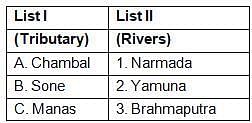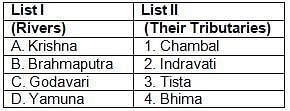टेस्ट: इंडियन ड्रेनेज सिस्टम - UPSC MCQ
29 Questions MCQ Test - टेस्ट: इंडियन ड्रेनेज सिस्टम
निम्नलिखित में से कौन सी नदी 'दरार' घाटी से होकर बहती है?
Which of the following river flows through the 'Darar' valley?
निम्नलिखित में से क्या भारत की पश्चिम बहने वाली नदी है?
1. महानदी
2. कृष्ण
3. नर्मदा
4. कावेरी
सही उत्तर चुनें
Which of the following is the west-flowing river of India?
1. Mahanadi
2. Krishna
3. Narmada
4. Kaveri
Select the correct answer
| 1 Crore+ students have signed up on EduRev. Have you? Download the App |
निम्नलिखित में से कौन सी नदी दक्षिण से उत्तर की ओर बहती है?
Which of the following river flows from south to north?
भारत में निम्नलिखित में से किस नदी को राष्ट्रीय नदी घोषित किया गया है?
Which of the following river has been declared as the National River in India?
निम्नलिखित में से कौन सी नदी यमुना की सहायक नदी नहीं है?
Which of the following river is not a tributary of Yamuna?
भारत की निम्नलिखित नदियों में से कौन सी नदी डेल्टा नहीं बनाती है?
Which one of the following rivers of India does not form a delta?
भारतीय रेगिस्तान की एक महत्वपूर्ण नदी है?
Which is an important river of Indian desert?
वर्तमान में कौन सी नदी अस्तित्व में नहीं है?
Which river does not exist at present?
भारत की कौन-सी प्रमुख नदी डेल्टा नहीं बनाती है?
Which major river of India does not form a delta?
गंगा नदियों के संगम का परिणाम है-
The result of the confluence of the Ganges rivers is-
सूची- II के साथ सूची- I का मिलान करें और का उपयोग करके सही उत्तर चुनें
नीचे दिए गए कोड:

ऊपर दी गई कौन सी जोड़ी सही ढंग से मेल खाती है / हैं?
निम्नलिखित में से कौन उत्तर से दक्षिण तक की नदियों का सही अनुक्रम है?
Which of the following is the correct sequence of rivers from north to south?
सूची- II के साथ सूची- I का मिलान करें और इनमें से सही उत्तर चुनें
नीचे दिए गए कोड:

जलाशय जीबी पंत सागर किस नदी पर स्थित है?
Reservoir GB Pant Sagar is situated on which river?
निम्नलिखित में से कौन सी नदी अरब सागर में बहती है?
Which of the following rivers flows into the Arabian Sea?
डेल्टा पूर्वी बहने वाली नदी प्रणालियों के लिए भारत में आम हैं, जबकि वे पश्चिम तट पर लगभग अनुपस्थित हैं क्योंकि पश्चिम-बहने वाली नदी
Deltas are common in India for east-flowing river systems, while they are almost absent on the west coast as west-flowing river systems.
प्रायद्वीप भारत की निम्नलिखित तीन नदियों में से कौन सी अमरकंटक क्षेत्र उनके स्रोत के रूप में है?
Which of the following three rivers of peninsular India have Amarkantak region as their source?
उत्तर से दक्षिण तक सिंधु नदी की निम्न सहायक नदियों की व्यवस्था करें:
1. चिनाब
2. झेलम
3. रवि
4. सतलज
नीचे दिए गए कोड का उपयोग करके सही उत्तर चुनें:
Arrange the following tributaries of the Indus river from north to south:
1. Chenab
2. Jhelum
3. Sun
4. Sutlej
Select the correct answer using the codes given below :
नदी और उसकी सहायक नदी के निम्नलिखित में से कौन सा युग्म सही रूप से मेल नहीं खाता है?
Which of the following pair of river and its tributary is not correctly matched?
अमरकंटक पहाड़ियाँ निम्न में से किस नदी का स्रोत है?
1. नर्मदा
2. महानदी
3. बने
4. बेटा
नीचे दिए गए कोड का उपयोग करके सही उत्तर चुनें:
Amarkantak hills are the source of which of the following rivers?
1. Narmada
2. Mahanadi
3. Became
4. Son
Select the correct answer using the codes given below :
निम्नलिखित में से किस नदी का सबसे बड़ा जलग्रहण क्षेत्र है?
Which of the following river has the largest catchment area?
भारत में निम्नलिखित में से किस झरने में सबसे अधिक ऊँचाई है?
Which of the following waterfalls in India has the highest height?
इनमें से कौन सी पश्चिम-बहने वाली नदियाँ दो पर्वत श्रेणियों के बीच बहती हैं?
Which of these west-flowing rivers flow between two mountain ranges?
गंडक नदी निम्नलिखित नदी प्रणालियों में से एक से जुड़ी है-
River Gandak is associated with one of the following river systems-
निम्नलिखित में से कौन सी अलकनंदा नदी की एक सहायक नदी नहीं है?
Which of the following is not a tributary of river Alaknanda?
निम्नलिखित में से कौन सा झरना - नदी ठीक से मेल नहीं खाता है?
सूची-I (नदी) के साथ सूची-I (टाउन) का मिलान करें और कोडों का उपयोग करके सही उत्तर चुनें

राजरप्पा किन नदियों के संगम पर स्थित है?
Rajrappa is situated at the confluence of which rivers?
ब्रह्मपुत्र नदी की निम्न सहायक नदियों पर विचार करें:
1. लोहित
2. तिस्ता
3. सुबनसिरी
4. संकोश
उपरोक्त नदियों को पश्चिम से पूर्व की ओर व्यवस्थित करें:
Consider the following tributaries of river Brahmaputra:
1. Lohit
2. Teesta
3. Subansiri
4. Sankosh
Arrange the above rivers from west to east :

















